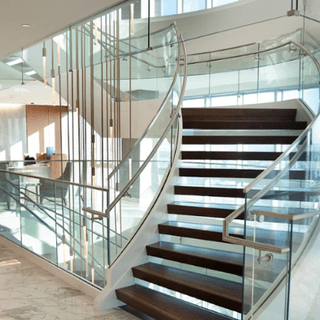Installing glass railings on stairs is the best way to increase safety and support while adding a beautiful design element to your space. Glass railings provide unobstructed views and pair well with modern and contemporary designs. To make sure ordering and installing glass railings goes smoothly, follow these tips.
Measure Accurately
Getting accurate measurements will help make the process of installing glass railings go smoothly and ensure you don’t come up short of having a large excess of materials. The guard height is measured from the stair nosing and should be at least 42 inches high — in our glass railings systems, the infill typically acts as the guard. Handrails should be between 34 inches and 38 inches above the stair tread nosings. These measurements will help you visualize and plan for installation, making sure to avoid any obstructions.
When you measure the length of the glass handrails, make sure to account for the extensions as required by the International Building Code (IBC) and the Americans with Disabilities (ADA) Standards for Accessible Design.
Choose the Right Materials
As long as you’re meeting building code requirements, choosing the right materials is highly dependent on the environment where the glass railings are located as well as the needs of the users. In the above example at the American Airlines Trinity Campus, the staircase is wide enough to require a free standing railing to add support in the middle of the staircase.
Determine Post Type
The glass railing system you choose will depend on a few different factors, including the type of post you want. Some glass systems come with traditional round posts while others feature cube-shaped posts or minimal fin-style posts. Some systems even forego posts altogether and opt for attaching the glass panel to each other or to the walking surface via a core or shoe mount.
For instance, fin-style posts of the SOLOTM Glass Railing System pictured above offer a minimal yet structured appearance. In this design, it allows for visibility, but the top mounted post system creates a sense of groundedness as the floating staircase ascends to the next floor.
Beyond the aesthetics, a significant factor in choosing a post type comes down to the visibility you need. While round posts still allow for a largely unobstructed view, the postless systems offer even more visibility and a streamlined modern look. If you need to install an intermediate handrail, you can choose the same post type or get creative.
Opt for the Best Mounting Method
Glass railings can be top, core, or fascia mounted, and some systems also offer shoe mounting capabilities. The mounting system that you opt for will depend on the overall design of the space and the type of glass railing system you choose.
Top mounted systems are the easiest to install as they are attached directly to the stairs. But the post hardware is also visible to anyone walking by. Core mounted railing systems require drilling down into the mounting surface and setting the post into it. While this takes longer and costs more, it provides an easy transition from the mounting surface to the post.
Fascia mounted systems are attached to the outside edge of the staircase allowing the hardware to become a design element in its own right. This system is more expensive than a top mounted system because it can be more difficult to access the mounting location. In shoe mounted systems, the glass panels rest in a base shoe, concealing the mounting hardware for a fully integrated appearance.
Follow Building Code Requirements
The handrail codes laid out in The International Building Code (IBC) and the Americans with Disabilities (ADA) Standards for Accessible Design are meant to create handrails that are safe and widely accessible to people of all age ranges and abilities. These standards include, but are not limited to the following handrail elements:
- Height
- Profile size and shape
- Graspability
- Clearance between the handrail and adjacent surface
- Spacing between handrails
- Projections
- Extensions
- Type of glass
Install Your VIVA Railings System with Confidence
Our glass railing systems meet and exceed building code requirements and are made from high-quality, durable materials, so you can install them with confidence. We offer a range of prefabricated systems with lots of customization options to ensure your railing system is specifically tailored to your needs. You can choose from a variety of post types and mounting methods that will fit your design, and the glass can be tinted, colored, or patterned to take your design even further.
Contact the experts at VIVA Railings today to see how our in-house team of designers, engineers, fabricators and more can help you design and install the ideal system for your space.


